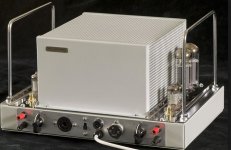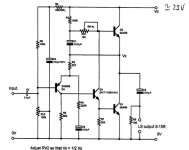You'd have to ask the guy i talked to… but he passed shortly after i talked to him 15 some years ago. The point of that was that WE, that was a giant in audio pre WWII was not doing voltage amps.
dave
Fairy nuff. In order to not muddy the waters too far as went round this loop with Atmasphere last fall could we agree that, pre-1954 speakers were different before Edgar Villchur turned everything on its head? I know some would claim that revolution was not for the better, but we are where we are 🙂
Nope this one http://www.firstwatt.com/pdf/art_cs_amps.pdf where he compares a voltage amp with a current amp+passive EQ. A bit of a cheat, but a very good demonstration of what can be done with a current source. Can be done with a voltage source too, although a linkwitz transform could be argued to be a far more elegant way of doing it as you don't throw watts away. Each to their own. We are talking a hobby after all.Which paper? The one where he adds a network to a voltage amp to emulate a current amp?
Guitar amps are musical instruments, not high fidelity. Does that really make the case for domestic music reproduction?The easiest way to see the effect of a current amp on the frequency response of a driver is a guitar amp: pentode amp with no feedback driving a 12" cone. Add lots of fb and you miss the trebles completely.
The attachments show an CHEAP 8" driver with whizzer cone when voltage driven (left) and current driven (right). Can you see the difference?
Yes, it's a bit of a cheat. A proper current amp can be better. Anyway, I think Pass did that simple experiment just to make a point. If one can avoid networks of any type no power will be wasted hence my previous point about the higher efficiency a priori of a voltage source. When power is limited it is a great advantage.Nope this one http://www.firstwatt.com/pdf/art_cs_amps.pdf where he compares a voltage amp with a current amp+passive EQ. A bit of a cheat, but a very good demonstration of what can be done with a current source. Can be done with a voltage source too, although a linkwitz transform could be argued to be a far more elegant way of doing it as you don't throw watts away. Each to their own. We are talking a hobby after all.
Guitar amps are musical instruments, not high fidelity. Does that really make the case for domestic music reproduction?
I think I have given you are real example showing the FR of two HiFi systems. As Pass did above, the guitar amp example is only a simple way to look at the difference. The point is exactly the same.....
The point may be the same, but it's irrelevant to this thread. What's presented here is:
1. This is a normal speaker system with added impedance correction networks.
2. The flat impedance means that the frequency response doesn't vary much with amp source impedance.
3. This comes at the cost of some wasted power. The networks reduce the efficiency.
4. No analysis has been yet presented showing why using a high source Z amp with this system is in any way better than using a low source Z amp.
5. No actual measurements or listening tests have been presented to show any advantages of the added components and reduced efficiency.
1. This is a normal speaker system with added impedance correction networks.
2. The flat impedance means that the frequency response doesn't vary much with amp source impedance.
3. This comes at the cost of some wasted power. The networks reduce the efficiency.
4. No analysis has been yet presented showing why using a high source Z amp with this system is in any way better than using a low source Z amp.
5. No actual measurements or listening tests have been presented to show any advantages of the added components and reduced efficiency.
I think somebody earlier wondered why I was talking about amplifiers in a loudspeaker forum. I think we might clear up the current amplifier versus voltage amplifier issue up first.
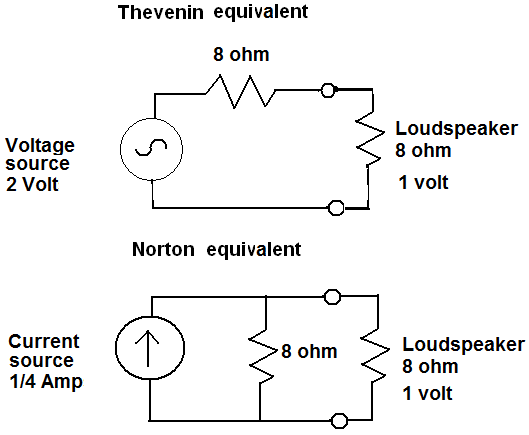
They can, IMO, end up in the same place. I always liked valve amplifiers. Like the Radford STA 25 below. Valves work as current amplifiers with voltage feedback essentially. These days, what I think is good about them is that valves are fast devices, and usually operate in Class A if you know what that is. In 1928 they were the only game in town.
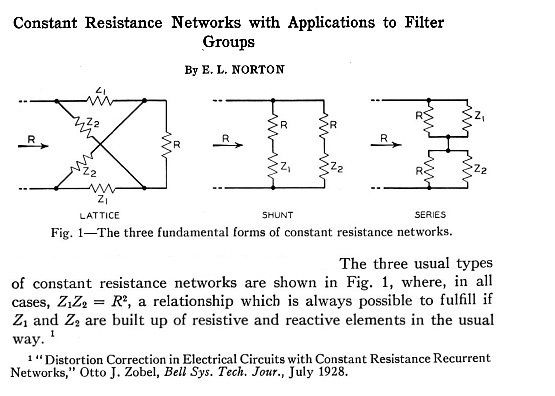
The "distortion" that Otto Zobel was addressing was essentially frequency response and waveform accuracy.
If you look at a modern Rotel RA 931 Class AB transistor amplifier, complete with Class AB crossover distortion, it is one of 4 solutions to the output impedance issue. And we could add Class A to the mix in Nelson Pass style. Or look at John Linsley-Hood's rather good Class A transistor amp from the 1960s. I have heard this one.
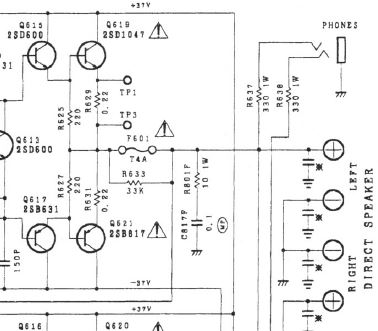
It is one of those old-fashioned ideas that you should match the source to the load for some sort of optimum. Ideally resistive. That is what Joe is doing here.
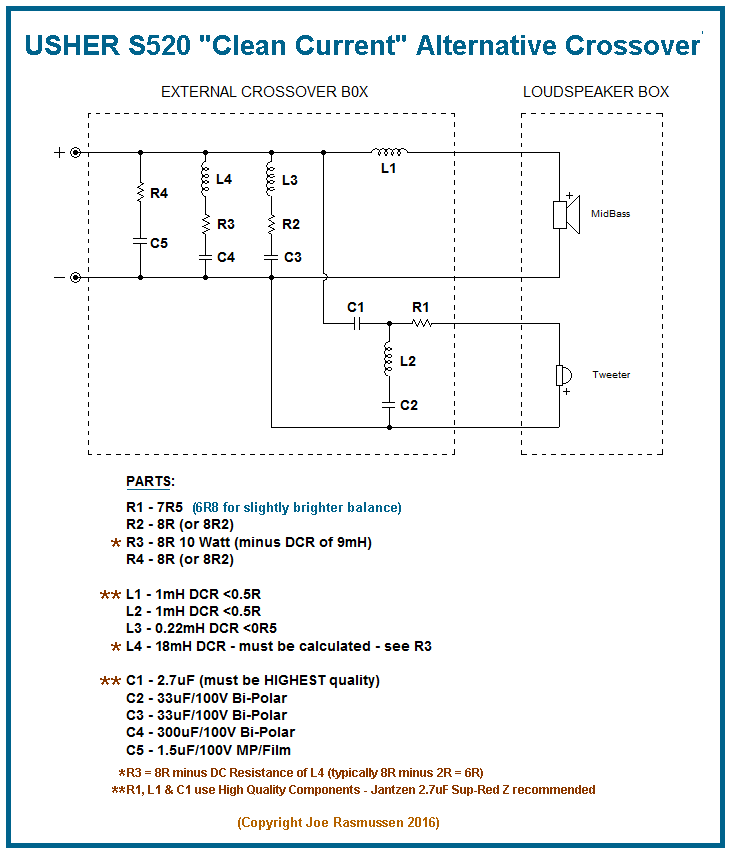
I think we need to try this idea.

They can, IMO, end up in the same place. I always liked valve amplifiers. Like the Radford STA 25 below. Valves work as current amplifiers with voltage feedback essentially. These days, what I think is good about them is that valves are fast devices, and usually operate in Class A if you know what that is. In 1928 they were the only game in town.

The "distortion" that Otto Zobel was addressing was essentially frequency response and waveform accuracy.
If you look at a modern Rotel RA 931 Class AB transistor amplifier, complete with Class AB crossover distortion, it is one of 4 solutions to the output impedance issue. And we could add Class A to the mix in Nelson Pass style. Or look at John Linsley-Hood's rather good Class A transistor amp from the 1960s. I have heard this one.

It is one of those old-fashioned ideas that you should match the source to the load for some sort of optimum. Ideally resistive. That is what Joe is doing here.

I think we need to try this idea.
Attachments
The Radford (I have one) is a high (for a valve amp) NFB design with an output impedance in the order of 0.3Ohms, so it's comparable with a solid state amplifier (or a Mac). It's a voltage source.
If one can avoid networks of any type no power will be wasted hence my previous point about the higher efficiency a priori of a voltage source. When power is limited it is a great advantage.
When power is limited surely doing things at line level is more of an advantage? I have no problem with the general approach of using the rising impedance of a driver near resonance in combination with either current drive or added source impedance (note this is mentioned by Rod Elliot as something he does in his active speakers for the bass). But the same net effect could be achieved with a passive shelving function before the power amp or with somewhat more control using an opamp to get the bass Q that you want.
Choice is good, this hobby would be boring otherwise!
I think everything might become more clear if we talk about power instead of voltage or current. Because in any practical system, you must have current and voltage to create power in the load. I think we can all agree that any wasted power is to be avoided if possible. That is why passive crossovers are a necessary evil if we only have one amplifier and we aren't talking about one of Dave's speakers. 🙂 Couldn't resist.
The alternative is what is called "actively crossed over" which uses one amplifier per speaker group and channel.
With regard to the situation where the damping factor = unity. Why would anyone design a system where the source dissipates as much power as the load? Especially when the goal is to dissipate power in the load and not the amplifier. Dave, I think this speaks to the conversation you reported about the WE engineer. The entire premise of equal load and source impedance is an RF thing. They are avoiding power loss in the transmission line, but this doesn't hold at audio frequencies and normal cable distances.
-Chris
The alternative is what is called "actively crossed over" which uses one amplifier per speaker group and channel.
With regard to the situation where the damping factor = unity. Why would anyone design a system where the source dissipates as much power as the load? Especially when the goal is to dissipate power in the load and not the amplifier. Dave, I think this speaks to the conversation you reported about the WE engineer. The entire premise of equal load and source impedance is an RF thing. They are avoiding power loss in the transmission line, but this doesn't hold at audio frequencies and normal cable distances.
-Chris
It is one of those old-fashioned ideas that you should match the source to the load for some sort of optimum. Ideally resistive. That is what Joe is doing here.
Not really. All he's doing is putting in networks which will cause the frequency response to be independent of source impedance, whether it's low, high, or in the middle. There's nothing special about having it be 2, 4, 5, 8, whatever ohms.
The point may be the same, but it's irrelevant to this thread. What's presented here is:
1. This is a normal speaker system with added impedance correction networks.
2. The flat impedance means that the frequency response doesn't vary much with amp source impedance.
3. This comes at the cost of some wasted power. The networks reduce the efficiency.
4. No analysis has been yet presented showing why using a high source Z amp with this system is in any way better than using a low source Z amp.
5. No actual measurements or listening tests have been presented to show any advantages of the added components and reduced efficiency.
I have only entered the discussion at some point on specific aspects. So my posts are relevant in that respect.
Regarding the thread, why should he present measurements and listening tests? Is that a new law in this forum?
If there's no analysis or data to back up performance claims, they're utterly worthless.Regarding the thread, why should he present measurements and listening tests?
If there's no analysis or data to back up performance claims, they're utterly worthless.
Untrue.
dave
And until we have proper studies that correlate what we measure to what we hear, choosing to use data to tell you what is heard is a subjective choice.
Measurements are useful, but far from complete or to quote Floyd Toole:
dave
Measurements are useful, but far from complete or to quote Floyd Toole:
Two ears and a brain are massively more analytical and adaptable than an omnidirectional microphone and an analyzer.
dave
With regard to the situation where the damping factor = unity. Why would anyone design a system where the source dissipates as much power as the load? Especially when the goal is to dissipate power in the load and not the amplifier. Dave, I think this speaks to the conversation you reported about the WE engineer. The entire premise of equal load and source impedance is an RF thing. They are avoiding power loss in the transmission line, but this doesn't hold at audio frequencies and normal cable distances.
-Chris
I really shouldn't try and have an intelligent conversation when buried in a bid, but I think we are in one of those areas where terminology can confuse depending on how you are looking at it. When you design a valve amplifier you have a nominal speaker impedance in mind as that drives the transformer ratio to give the correct load to the output stage. But this is not the same as the source impedance matching the load impedance, esp when you have a bit of negative feedback.
But SY is right, all completely off track to the thread.
Hi Dave,
Your average human is a very poor judge of absolute anything. Show me a calibrated human, and the history of calibrations to show drift or wandering. Thank goodness for "omnidirectional microphone and an analyzer.", but make the mics and analyzers plural.
-Chris
... but make poor absolute instruments.Two ears and a brain are massively more analytical and adaptable than an omnidirectional microphone and an analyzer.
Your average human is a very poor judge of absolute anything. Show me a calibrated human, and the history of calibrations to show drift or wandering. Thank goodness for "omnidirectional microphone and an analyzer.", but make the mics and analyzers plural.
-Chris
Hi Bill,
Correct. It's a good thing that tubes don't have a single load impedance they want to "see". Very familiar with the concept.
Off track seems to be the norm for some threads. I do agree with you though.
-Chris
Correct. It's a good thing that tubes don't have a single load impedance they want to "see". Very familiar with the concept.
Off track seems to be the norm for some threads. I do agree with you though.
-Chris
Hi Dave,
... but make poor absolute instruments.
Indeed, but that's why we do actual listening tests, which (as I said) have also not been presented.
I thought it was intended to remove frequency dependence from distortion produced within the amp/speaker interface, while giving an easy load to drive (easy meaning non-reactive, the actual Zmagnitude being just arbitrary)....that you should match the source to the load for some sort of optimum. Ideally resistive. That is what Joe is doing here.
Anyway, I agree on the JLH. Very nice amp. Oddly I have noticed less benefit over the years conjugating crossover region impedance and yet my amps have only risen in Zo.
And until we have proper studies that correlate what we measure to what we hear, choosing to use data to tell you what is heard is a subjective choice.
Further… breakthroughs in audio are almost always preceded by someone hearing something. One of the most significant in recent times was jitter… 1st heard then years later after lots of work we were able to measure it and reduce it with significant gains in digital performance.
Joe has presented us with an experiment that allows others to see if they hear what he hears. If they do we can pursue why, if not we can toss it.
dave
- Status
- Not open for further replies.
- Home
- Loudspeakers
- Multi-Way
- Joe Rasmussen Usher S520 "Current Compatible" Crossover
